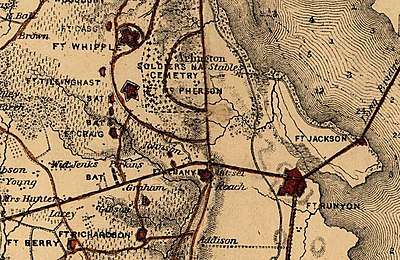Arlington Line
The Arlington Line was a series of fortifications that the Union Army erected in Alexandria County (now Arlington County), Virginia, to protect the City of Washington during the American Civil War (see Civil War Defenses of Washington and Washington, D.C., in the American Civil War).[1]

Just across the Potomac River from the Union capital city, Confederate Virginia was a major Union concern when the war began. In May 1861, federal troops seized much the County and immediately began constructing a group of forts near Washington on the Virginia side of the River to protect the capital city.
After the Confederate Army routed the Union Army at the First Battle of Bull Run (Manassas) in late July 1861, the Union Army began construction on a line of breastworks and lunettes to the west of the earlier fortifications. These and larger fortifications later constructed nearby became known as the Arlington Line. They included a lunette (Fort Cass) and Fort Whipple, which became parts of Fort Myer, later to be renamed as Joint Base Myer–Henderson Hall.
The Arlington Line was never attacked, even after the federal defeat at the Second Battle of Bull Run (Manassas) in late August 1863. The Line therefore effectively served its strategic purpose.
Major Daniel Phineas Woodbury was the Union engineer who designed and constructed the Arlington Line. One of its forts, Fort Woodbury (which once stood in what is today Arlington's Courthouse neighborhood), was named for him.
Notes
- (1) Michael, John (2011-03-06). "Fort Cass Virginia: The Fortification Begins". Images of America: Fort Myer. Archived from the original on 2018-12-28. Retrieved 2018-12-28.
After the fall of Fort Sumter, South Carolina to the Confederates, it was decided that the Nation’s Capital was in need of defenses. Among the first fortifications were built were the ones at the three crossings of the Potomac River – Chain Bridge (Fort Ethan Allen), Aqueduct Bridge (Fort Corcoran) and Long Bridge (Fort Jackson). Over time the Arlington Line of fortifications developed beginning at the Potomac and encircling the western side of the Capital on the Virginia side.
The line consisted of about 30 forts, augmented by interwoven artillery batteries:
Fort Marcy, Fort Ethan Allen, Fort C. F. Smith, Fort Bennett, Fort Strong, Fort Corcoran, Fort Haggerty, Fort Morton, Fort Woodbury, Fort Ramsey (which later renamed and became Fort Cass), Fort Whipple, Fort Tillinghast, Fort McPherson, Fort Buffalo, Fort Craig, Fort Albany, Fort Jackson, Fort Runyon, Fort Richardson, Fort Barnard, Fort Berry, Fort Scott, Battery Garesche, Fort Reynolds, Fort Ward, Fort Worth, Fort Williams, Fort Ellsworth, Fort Lyon, Fort Farnsworth, Fort Weed, Fort O’Rourke, Fort Willard
(2) "The Arlington Line". Arlington County, Virginia: Arlington Historical Society. Archived from the original on 2012-04-20.
(3) Cooling III, Benjamin Franklin; Owen II, Walton H. (2010). The Arlington Lines. Mr. Lincoln's Forts: A Guide to the Civil War Defenses of Washington (New ed.). Lanham, Maryland: Scarecrow Press. p. 82. ISBN 978-0-8108-6307-1. LCCN 2009018392. OCLC 665840182. Archived from the original on 2018-12-28. Retrieved 2018-03-05 – via Google Books.